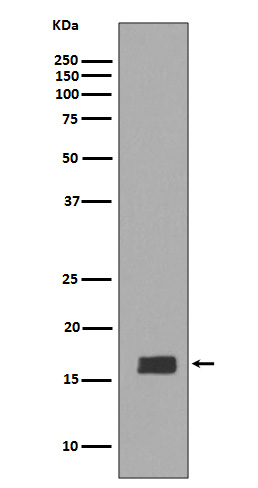
| WB | 咨询技术 | Human,Mouse,Rat |
| IF | 咨询技术 | Human,Mouse,Rat |
| IHC | 咨询技术 | Human,Mouse,Rat |
| ICC | 1/50-1/200 | Human,Mouse,Rat |
| FCM | 1/20-1/100 | Human,Mouse,Rat |
| Elisa | 咨询技术 | Human,Mouse,Rat |
| Aliases | alpha synuclein; beta synuclein ; NACP; PD1 ; SNCA; SNCB;;alpha/beta Synuclein |
| WB Predicted band size | Calculated MW: 14 kDa ; Observed MW: 18 kDa |
| Host/Isotype | Rabbit IgG |
| Antibody Type | Primary antibody |
| Storage | Store at 4°C short term. Aliquot and store at -20°C long term. Avoid freeze/thaw cycles. |
| Species Reactivity | Human,Mouse,Rat |
| Immunogen | A synthesized peptide derived from human alpha Synuclein |
| Formulation | Purified antibody in PBS with 0.05% sodium azide,0.05% BSA and 50% glycerol. |
+ +
以下是3篇关于α-synuclein和β-synuclein抗体的代表性文献概要:
1. **《α-Synuclein in Lewy bodies》**
- Spillantini MG, et al. (1997) Nature.
- 首次报道α-synuclein作为帕金森病路易体的主要成分,开发的抗体CHL-1和15G7能特异性识别病理性α-synuclein聚集物。
2. **《β-Synuclein inhibits α-synuclein aggregation》**
- Hashimoto M, Masliah E (1999) Mol Cell Neurosci.
- 通过比较特异性抗体(如抗β-synuclein单克隆抗体4B2),证明β-synuclein能抑制α-synuclein的纤维形成,提示其神经保护作用。
3. **《Antibody-specific detection of α/β-synuclein》**
- Beyer K, et al. (2005) J Neurosci Methods.
- 系统评估多种商业抗体(如抗α-synuclein抗体LB509、抗β-synuclein抗体SIGMA S3062),通过Western blot和免疫组化验证其亚型特异性,发现部分抗体存在交叉反应。
4. **《Functional roles of synucleins》**
- George JM (2002) J Mol Neurosci.
- 综述中讨论了使用特异性抗体区分α/β-synuclein亚型的策略,强调β-synuclein抗体在解析其抑制α-synuclein病理中的作用。
Alpha-synuclein (αSyn) and beta-synuclein (βSyn) are small, soluble proteins belonging to the synuclein family, primarily expressed in neurons. αSyn is extensively studied due to its central role in neurodegenerative disorders, particularly Parkinson’s disease (PD) and other synucleinopathies, where it forms pathological aggregates in Lewy bodies. In contrast, βSyn shares structural homology with αSyn but exhibits distinct biochemical properties, potentially inhibiting αSyn aggregation and modulating its toxicity. Antibodies targeting αSyn and βSyn are critical tools for investigating their physiological functions, pathological roles, and interactions.
αSyn-specific antibodies are widely used in research and diagnostics to detect pathological forms (e.g., oligomers, phosphorylated species) in brain tissues, biofluids, or experimental models. They aid in elucidating mechanisms of neurodegeneration and evaluating therapeutic strategies. βSyn antibodies, though less studied, help explore its neuroprotective roles and regulatory interplay with αSyn. Both monoclonal and polyclonal antibodies are developed, often validated via techniques like immunohistochemistry, Western blot, and ELISA.
Challenges include ensuring specificity due to sequence similarities among synuclein family members (α, β, γ) and distinguishing between normal and disease-associated conformations. Recent advances in epitope mapping and conformation-sensitive antibody design enhance diagnostic accuracy. These antibodies also hold potential as biomarkers in cerebrospinal fluid or blood for early disease detection. Continued refinement of synuclein-targeting antibodies remains vital for understanding synuclein biology and advancing therapies for neurodegenerative diseases.
×